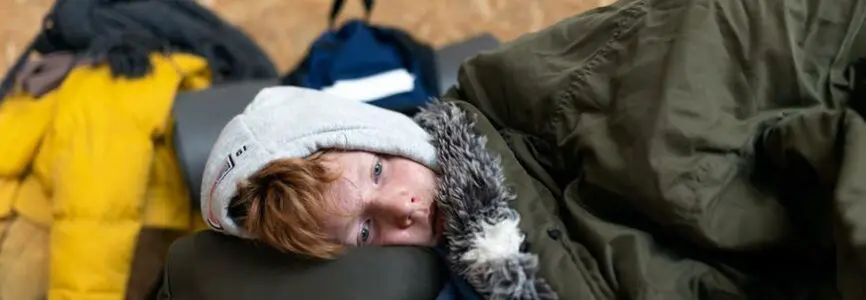Bioethics Forum Essay
Ethical Placemaking for Refugees
More than 4 million people have fled from war and terror in Ukraine. Numbers increase by the day. Neighboring countries are granting shelter and protection, people are making space in their private homes, in Airbnbs, in hotels. One project funded by New Zealanders is converting Slovak barns that once housed Nazis into refugee accommodations. The amount of help and donated money and goods for people (and their pets) is overwhelming. What was coined as “welcome culture” in Germany in 2015, when many refugees were greeted warmly and welcoming especially by volunteers and private supporters, is repeating itself.
And yet, refugees from other places face the same deterring policies and practices as usual. They must now make space for Ukrainian refugees and are thereby being torn from established structures such as language classes and schools. Conditions in Syria (also partly due to Russian bombardment), the Central African Republic (where Russian-backed mercenaries operate), and in many other countries including Eritrea, Mali, and Yemen are also dire. Desperate people from these places take the perilous journey across the Mediterranean Sea (where already in 2022 an estimated 227 people are dead or missing) in most cases to meet with hostility, barbed wire, and a state of protracted limbo. Some are using the terms first- and second-class refugees: one Swiss newspaper even spoke of “real” refugees when referring to Ukrainian refugees.
What is, once more, becoming brazenly clear is not only the impotence of the existing international apparatus designed to protect the worldwide 70 million forcibly displaced people, but also its asymmetries. Here we refer not only to the Refugee Convention, which has never been enforceable and has run aground in recent years around conceptions of “persecution.” We also include governments and civil societies around the world that have proven xenophobic and willing to flout international law, and some would say even basic decency.
If there is moral indignation over what is happening in Ukraine, why is there not similar outrage concerning Syria and other places that are inhospitable? The usual diagnosis of such asymmetries points to the co-morbidities of ethnocentrism and stereotyping, scapegoating, and economic anxiety.
What might we do – what should we do – to engage moral imaginations in order to generate recognition for those relegated to languishing as refugees? How should we overcome the risk of selected, exclusive, short-term (a worry even for Ukrainians in the European Union, whom we should note have been toward the bottom of Europe’s ethnic hierarchies until recent weeks) solidarity? How could we shift from seeing certain people as foreigners to be feared and resisted to seeing our fellow humans struggling to survive, many of whom will need long-term assistance given the trauma suffered?
Ai Weiwei’s inspiring documentary, Human Flow, includes a section of stunning portraits of people fleeing Middle Eastern and African countries. They are standing still, thereby requiring the viewer to stop for close to a minute and regard them as if they are works of art – not in a way that objectifies or pities. It is a breathtakingly beautiful series in form and content. He disrupts the destructive binary between us and them, between deserving and undeserving. This is ethically significant filming. Instead of presenting people usually depicted as dirty, bloodied, and impoverished, it elicits recognition and respect for universal human dignity and an appreciation for our individuality. Weiwei builds solidarity in this way – he sparks the moral imagination to recognize the needs of others and humanitarian action in some form.
Part of what is poignant about his gesture is that his “subjects” are filmed on a humanitarian ship, against a gleaming white backdrop, excerpted in a sense, extracted from their origins. And, for the most part, all we know of them is that these human beings are headed to some other place. After all, when the bombs start exploding or the water dries up, the first question people ask is, “Where can we go?”
The depth of solidarity and empathy and the swiftness of action by the international community toward the Ukrainian refugee crisis has been striking. Without hesitation, people in the region and around the world have recognized the urgent need and rapidly responded. Specifically, they have responded by creating places for refugees. As they should.
Recognizing the suffering of displaced people in conditions unable to sustain them follows from the most minimal appreciation of them as fellow human beings. Still another feature of Human Flow is its poignant depictions of desertification, oil fields on fire with their spiraling black smoke, and also refugee encampments in their remote, sprawling monotony. Recognizing that no one could live in such places is one way to see our shared humanity, ultimately, our moral equality. This can – and should – generate a solidaristic response.
Understanding the importance of place ties us together. As fellow human beings, we understand that our subjectivity, identity, and relations as ecological subjects are dependent on places. It also emphasizes our interdependence. We have historic and contemporary connections to people around the world and, as a result, have contributed to their plight, often unintentionally and indirectly. Some of the ties that bind us are more evident than others. Connections like ancestry, ethnicity, religion, and geography can seem obvious, whereas economic or historical links (like to trade or colonization) are not always as clear. But these less evident and sometimes circuitous links also ground responsibilities to respond; where these connections create or perpetuate injustice, they generate responsibilities. One starting point for fulfilling these responsibilities – and, indeed, promoting transitional justice – is ethical place-making. We refer here not only to the place needed for emergency shelter (which also warrants further attention), but also a truly ethical place where people can care and be cared for, physically secure, exercise agency and autonomy, build relations and feel rooted over time.
We can do better, ethically, if we think of ourselves (all of us) more explicitly as ecological subjects, people who are radically interdependent: we are embodied (which relies on others’ embodiment); embedded socially; and need to be situated in certain atmospheric, geographic, and material environs. Place is critical to our ability to flourish. Interdependence between peoples and places, moreover, grounds responsibility for justice.
Attention to place is important for our own academic communities in bioethics and especially public health ethics and global health ethics, as a central concern for these disciplines is a just distribution of the ability to flourish. Refugees – many enduring some disability – arrive in hospitals and clinics, doctors’ offices, and all the other places where health care is provided. We must, therefore, argue for responsibilities to support ethical place-making in places of patient care, including finding ways to better respond to the needs of distinct populations. At the societal level, we can also argue for the moral (and practical) necessity of public health policies that support the importance of ethical place-making. We can argue, for example, for deploying mobile units for refugees on the move and establishing care and health resource sites at border crossings. Overcrowded and unsanitary shelters and other forms of accommodation threaten physical and mental health, and catalyze frustration and aggression. In communities where refugees settle, we can advocate for the deployment of embedded care resources, in addition to adequate housing fostering the ability to build relations, exercise agency, feel safe, healthy, and rooted. We can participate in efforts to resist and reduce distrust, stigma, and other barriers to health care and well-being, literally building trust in the ways we design institutions, care settings, interventions, and interactions with attention to place. Finally, we can and should argue for revisiting and realigning the Refugee Convention to better respond to contemporary realities of why people are compelled to flee their homes for the sake of individual, public, and global health. For people everywhere, this requires a sense of place. We should work to ensure it through our international legal instruments and conventions, our public health policies, and the design of our care institutions and encounters.
We close by making a much broader call for ending the war in Ukraine, and wars elsewhere, to protect and create safe and healthy places for people where they feel they belong and where they can flourish. The obvious task, also for bioethicists who are interested in ethical place-making, is to do everything we can to prevent and fight against forced displacement in the first place.
Lisa Eckenwiler, PhD, (@lisaaeck) is a professor of philosophy and department chair at George Mason University. She is vice president of the International Association of Bioethics and a Hastings Center fellow. Verina Wild, PhD, (@VeriWil) is a professor of medical ethics at the University of Augsburg in Germany.














Thank you for these comments…quite sorely needed…
Thank you Lisa and Verina for this essay. I very much appreciated that you drew our attention to the asymmetry in refugee accommodation that we are witnessing in the wake of the conflict in Ukraine. I am reminded of Judith Butler’s line of questioning in Precarious Life: The Power of Mourning and Violence, where she asks, “Who counts as human? Whose lives count as lives? And, finally, What makes for a grievable life?” Who are we willing to make space for and why?
Our perception of people is indeed deeply entwined with the places they come from, and when there is a disruption of the social and geopolitical and physical landscape that is seemingly at odds with the cultural, religious, and racial identities of the people that live there, we feel its impact more greatly, more personally. What we know about Ukrainians from the media is that they are white, European, and Christian, and therefore made more grievable to us as a Western audience. This framing determines where we donate money, whether we open our homes, whether we meet them at our shores with a cup of tea or armed officers. It determines whose health, safety, and wellbeing we feel obligated to ensure and maintain. This type of moral responsibility is lacking when we consider other places, like Yemen for example, a Middle-Eastern, majority-Muslim country, a place in which we have come to expect war, conflict, suffering, and displacement. We feel no disruption, no nagging moral obligation, because this is a place far removed from us, where suffering is a foregone conclusion. I think that ethical placemaking has the potential to be a justice tool, to re-direct care and attention if we do it in a way that takes into account the marginalized identities of the refugees that will be in these spaces. Is there a place for prayer and worship in the facilities we build? In our clinics, are there places for cover for women that want to preserve their sense of modesty? Refugees are already in such a vulnerable and exposed position, and tending to their social, spiritual, and cultural needs should be prioritized in the planning and building of our care delivery spaces and systems.
I love this notion of flipping the lens on ourselves as ecological subjects, and thinking of our own intercorporeality, and the relation between our environments. This is not easy, especially in American society, where individualism and independence are regarded so highly. The recognition of our interdependence requires us to subvert and resist the dominant narrative.
I also watched a little bit of Human Flow, and was also struck by the portrait shots that you mentioned. It felt like I was watching live subjects watch me back. Their gazes implicate me as a viewer. It was very powerful. I am questioning, though, why it is that we have to remove these people completely from their context, erase their origins, or their current place, and position them in front of a white screen in order to recognize their humanity? Perhaps I’d like to push back a little against the notion that this erasure is the ideal way to facilitate a meaningful encounter.
Apologies for such a long reply!